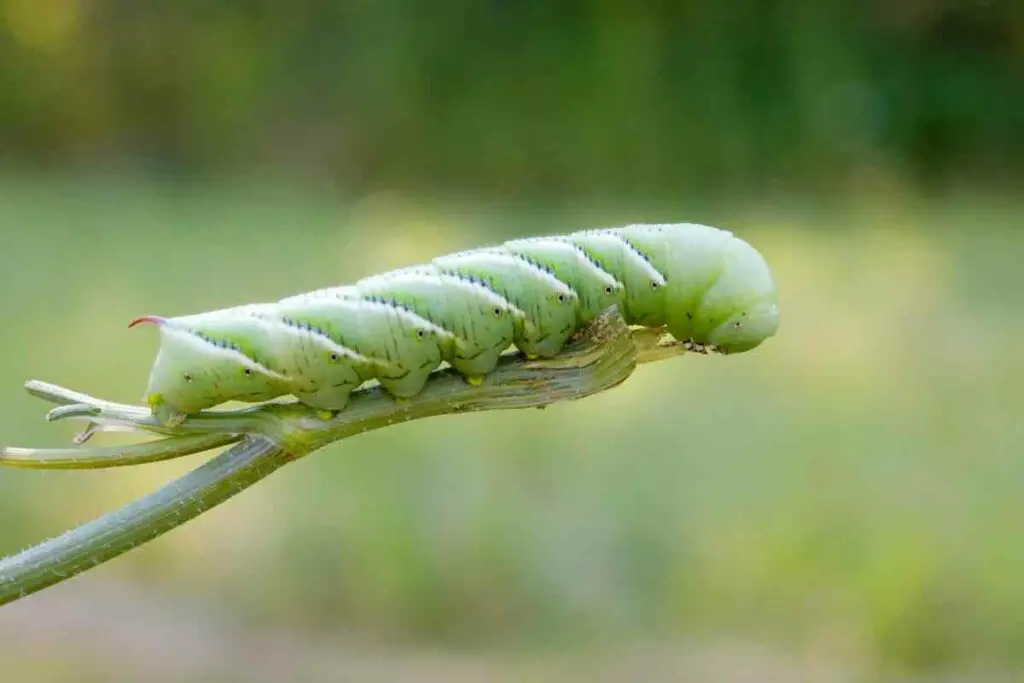Believe it or not, learning how to get rid of tomato hornworms is a lot easier than most people expect. All it really involves is telling your soil a little more frequently, leveraging “trap” crops and partner plants, or helping build up the natural hornworm predator population around your tomato patch.
Below we dig a little deeper into (almost) everything you need to know about vanishing tomato hornworms from your vegetables once and for all!

Confirm It’s Hornworms Plaguing Your Plants
The first step to getting hornworms out of your tomato patch is to make sure that they are the culprits causing all the damage in the first place.
If you see long, green, spiked caterpillars crawling all over your tomatoes (and your peppers, potatoes, and eggplant, as well) the odds are pretty good you’re dealing with a hornworm infestation.

These up to 5 inch long little buggers can wreck a tomato crop faster than you would have ever expected, too – which is why you need to get out in front of the problem ASAP.
You’ll also know if you see black droppings on your plants or huge holes in your tomato leaves. Those are dead ringers that your plants are getting crushed by hornworms.
How to Get Rid of Tomato Hornworms
The good news about getting rid of hornworms is that you don’t have to use chemicals or insecticides to get rid of these little buggers.
Here are a couple of different approaches you’ll want to try to wipe out any hornworms that have holed up in your tomatoes.
Till Your Soil More Often
While more and more people are turning to no-till style gardening, tilling your soil a little more frequently is a great way to eliminate the hornworm pupae that would later hatch into the hungry caterpillars that will crush your tomato plants almost overnight.

Till the soil in the spring, expose these bugs to colder temperatures, and wipe them out before they even take hold.
Pluck Hornworms from Your Plants
Probably the easiest way to get rid of hornworms is to simply post up on your tomato plants for an hour or so each night and just pluck them off the veggies when you spot them.
This is a little time consuming and tedious, to be sure, but it’ll only take a couple of nights before you have wiped out the whole crew.
Getting rid of the little buggers is simple as well – just pop them – unless you are keeping chickens. Chickens go wild for hornworms.
You can just dump them in the chicken run and they’ll be gone in 30 seconds flat.
Lean on “Trap” Crops
Trap crops are basically sacrificial crops you plan near your “money crop”, designed to lure pests away and leave your good plants alone.

Flowering tobacco plants work wonders to pull hornworms away like a tractor beam!
Use Partner Plants to Drive Hornworms Away
Partner plants are different kinds of plants you grow next to one another, with each plant giving a benefit to the other plants in the area.
Basil planted near tomatoes, for example, will not only improve the flavor of the tomatoes themselves – but it will also work to actively repel the hornworms away from your juice, plum tomatoes, too.
Parsley, dill, mustard, yarrow, and marigolds are just some of the partner plants you’ll want to think about using.
Encourage Hornworm Predator Populations
There are a whole bunch of insects that will take care of your hornworm population for you, natural predators that will eat these bugs and stop them from plaguing your plants – and they won’t harm your tomatoes, either.

We’re talking about insects like ladybugs and lacewings. You can get starter populations of these beneficial bugs online or maybe even at your favorite local garden center.
Start the population, support it’s growth, and turn them loose on your hornworms to keep those troublesome bugs away without having to lift a finger on your own.
Spray Your Tomatoes Down with Cayenne Pepper
Believe it or not, you can make your own DIY bug spray – 100% all natural and safe, of course – to use against hornworms without a lot of headache of hassle.
All you’ve got to do is mix up a little bit of cayenne pepper, some tap water, and a little bit of dish soap.
Shake the mixture up in a water bottle and then gently spritz the mixture on the tomato plants you’re looking to protect.
The capsaicin in the peppers will drive hornworms away, with the soap helping to hold that pepper juice on the plants for a little while to act as a defensive barrier if the hornworms come back.
How to Prevent Hornworms in the First Place
Of course, the best way to never have to worry about hornworms at all is to stop them from infecting your plants in the first place.

And that means preventing them from taking hold in your tomato patch.
Row Covers Work Wonders
A simple solution to stopping hornworms from establishing themselves in your garden is to use some row covers.
Immediately after planting your nightshades you’ll want to cover them with either floating row covers or a high tunnel.
You can leave those row covers on until it’s time for your plants to be pollinated – and by that time you won’t have any hornworms to contend with.
Diatomaceous Earth is a Neat Trick That Works, Too
DE (diatomaceous earth) is a sometimes controversial solutions to fight back against hornworms, but a lot of gardeners swear by it.
The idea is to spread this stuff around your tomato plants, basically created a natural line of defense a couple of inches wide.
Then, if the hornworms crawl across it, the DE will attach itself to them and dry them out – dehydrating and killing them along the way.
Spread this stuff in the spring for the best possible impact.
Black Plastic in the Spring Stops the Hornworm Lifecycle
Black plastic coverings over your tomato plants in the springtime can trap the hornworm moths inside, preventing them from dropping new eggs on your plants and slamming the brakes on the first part of a hornworm lifecycle.
No moth penetration means no eggs, and no eggs mean no new hornworm population.
Best of All – You can pop the plastic off as spring winds down and not have to worry about these hungry little bugs robbing you of your precious late summer tomato crop!
- How to Dry Basil Leaves: A Professional Guide
- Is an Avocado a Fruit or Vegetable? Simple Answer and Explanation
- Does Pineapple Have Seeds? Exploring the Anatomy of Pineapples
- Blooming Through Winter: Can I Grow Vegetables Indoors in the Winter?
- What Can You Grow in a Greenhouse All Year Round: A Guide to Year-Round Greenhouse Gardening
- Are Blueberries Blue? Debunking the Myth of Their Color
















